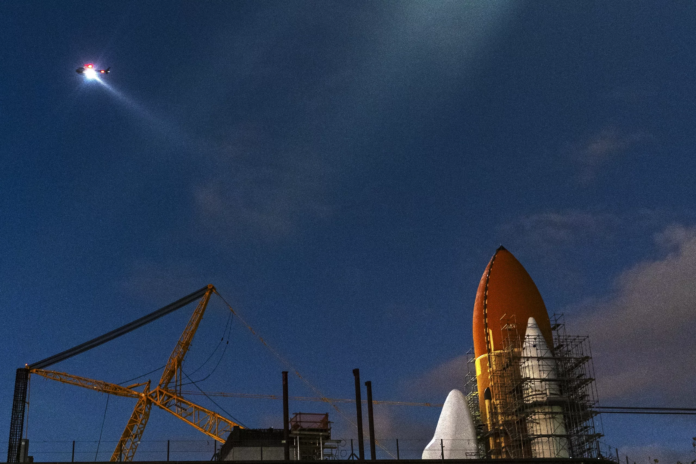America’s space shuttle program burned through almost $200 billion over the course of three decades from 1981 to 2011, but it failed to live up to expectations. A new examination has arrived at a sobering conclusion: “By every measure, the shuttle had fallen short of even the modest hopes that had surrounded it. And the shuttle remained flying only because every effort to replace it with a better-winged, reusable craft also failed.”
According to Matthew H. Hersch, a professor of the history of science at Harvard University, in his latest book, Dark Star: A New History of the Space Shuttle, this was not due to any technical failings or management errors. Rather, it stemmed from “the shuttle’s design and its fundamental lack of purpose.”
Many at NASA and within the Air Force were not convinced by the concept of a “jack of all trades” spacecraft that took off like a rocket and landed like a plane. The whole idea of building such a spacecraft with wings, even though they were a hindrance for most of the journey and only needed for landing, failed to garner widespread support.
Ultimately, the space shuttle was a political compromise that was intended to satisfy a large number of what were frequently conflicting interests and requirements. The shuttle was expected to fulfill a range of tasks, including as a carrier for scientific satellites, an orbital laboratory, a craft to service space stations and interplanetary ships, a delivery vehicle for commercial payloads, a tool of diplomacy and international cooperation, and a military spaceplane.
Many of these functions could have been accomplished without the need for a manned spacecraft. And when you consider that 14 astronauts died in the Challenger disaster in 1986 and the Columbia disaster in 2003, this raises the question of whether it was appropriate to expose people to such risk when almost all of these tasks could have been performed more cheaply and with less risk by unmanned spacecraft.
The costs were much higher than expected: Each flight cost an estimated $500 million, which was similar to the cost of Apollo-era launches. Carrying a one-pound payload proved to be about 10 times more expensive than the optimistic forecasts had predicted and certainly not less than the costs associated with traditional, nonreusable rockets. Experts such as Reiner Reichl even estimate the costs at over $1 billion if development costs, maintenance, renewal, and other expenses are included.
Often, extraneous motives played a role. For example, Rockwell International was commissioned to manufacture the spaceship because President Richard Nixon wanted to award the contract to a company based in the swing state of California in the run-up to the 1972 election.
“Companies in congressional districts across the country manufactured the wings, rudder, and other portions of the orbiters to ensure the shuttle’s support by a diverse array of lawmakers, and then shipped the parts to Rockwell’s plant in Palmdale, California, for final assembly,” Hersch writes.
Contracts were frequently awarded based on political considerations, a practice that continues to this day. For instance, the decision to commission Thiokol to manufacture the space shuttle’s solid rocket boosters remained clouded by accusations of favoritism by Utah politicians and civil servants. The Challenger’s tragic demise in January 1986 could have been prevented if Thiokol’s management had not made the misguided decision to authorize the launch. This is all the more tragic because one of the company’s employees had emphatically warned that the O-rings that sealed the joints in the shuttle’s SRBs could become dangerously stiff in cold weather, which is what happened on that day and led to the catastrophe.
The crew included a teacher, who died along with the six astronauts, effectively ending any plans for private space tourism with the shuttle for the foreseeable future. While flying on the shuttle was no more dangerous than the Apollo spacecraft, with the higher casualty count simply being a result of the larger crew size, some mistakenly believed that shuttle flights were as safe as a trip on an airplane. The professional astronauts, however, knew this was not true.
Following the Challenger’s destruction, all launches were suspended for over two years, which meant that another task, that of transporting private satellites into space, was also suspended. This unexpected pause in operations turned out to have a positive impact.
CLICK HERE TO READ MORE FROM THE WASHINGTON EXAMINER
Hersch is right in his criticism that government monopolization of space travel hindered its development. “Instead of exploring space, NASA would replace the embryonic free market for launch services with a single government provider that purchased expensive, unreliable rockets from key defense contractors selected by political appointees, and then priced their flights below cost for favored users, destroying the competitive pressures that might have improved the technology,” he writes.
In August 1986, President Ronald Reagan decided that “NASA will no longer be in the business of launching private satellites.” This paved the way for private providers, a vision Reagan had already outlined in a speech a year-and-a-half earlier: “Companies interested in putting payloads into space, for example, should have ready access to private sector launch services. … So, we’re going to bring into play America’s greatest asset — the vitality of our free enterprise system.”
Rainer Zitelmann is the author of The Power of Capitalism and How Nations Escape Poverty.




